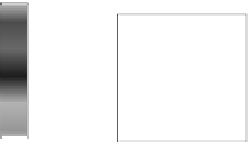Biomedical Engineering Reference
In-Depth Information
he goal of this study was to the quantify the specimen-induced aberrations for a representative variety
of biological specimens. herefore, we had to select a set of common biomedical specimens. Some of them
are listed in Table 4.2 and the specimen numbers listed there will be referenced in the following discussion.
4.11 Example Results for High Numerical Aperture
Ater the described Zernike mode extraction, each coeicient
M
i
may be represented as a Zernike mode
pseudo-image that shows the variation of
M
i
as one scans across the specimen. Figure 4.15 displays an
example for the
C. elegans
specimen. Here modes 5 through 12 are depicted. he total Zernike igure is
calculated using
(
)
/
1 2
22
M
i
2
.
i
=
5
For the purpose of designing and implementing adaptive optics, it is important to consider the
variations of the aberrations across the ield of view. he mean and the standard deviation for each
mode were calculated from maps such as shown in Figure 4.15; a result for the
C. elegans
is shown in
Table 4.2
Approximate hickness, Lateral Scan Range, and Embedding Medium of the
Specimens We Investigated
Specimen Number
Description
Embedding
hickness (μm)
Lateral Scan (μm)
1
Brain tissue, rat
PBS
30
120 × 120
2
Mouse oocyte
PBS
80
125 × 125
3
Liver tissue, mouse
PBS
20
20 × 20
4
Striated muscle, rat
PBS
40
50 × 50
5
C. elegans
Agar gel
40
50 × 50
6
Vas deferens, rat
PBS
30
50 × 50
PBS, Phosphate-bufered saline.
Total Zernike
Mode 2—Tip
Mode 3—Tilt
2
3
2
1
1
0
‒
1
‒
2
0
‒
3
2
Mode 4—Defocus
Mode 5—Astigmatism
Mode 6—Astigmatism
Mode 7—Coma
1
0
‒
1
‒
2
Mode 8—Coma
Mode 9
Mode 10
Mode11—Spherical (1st)
Mode 12
Figure 4.15
Zernike mode pseudo-images of the specimen number 5,
C. elegans
. he Zernike mode amplitudes
M
i
of modes 2 through 12 (for the Zernike mode units, see deinition in Equation 4.4) are depicted.









































































































































































































































